Page 509 of 723
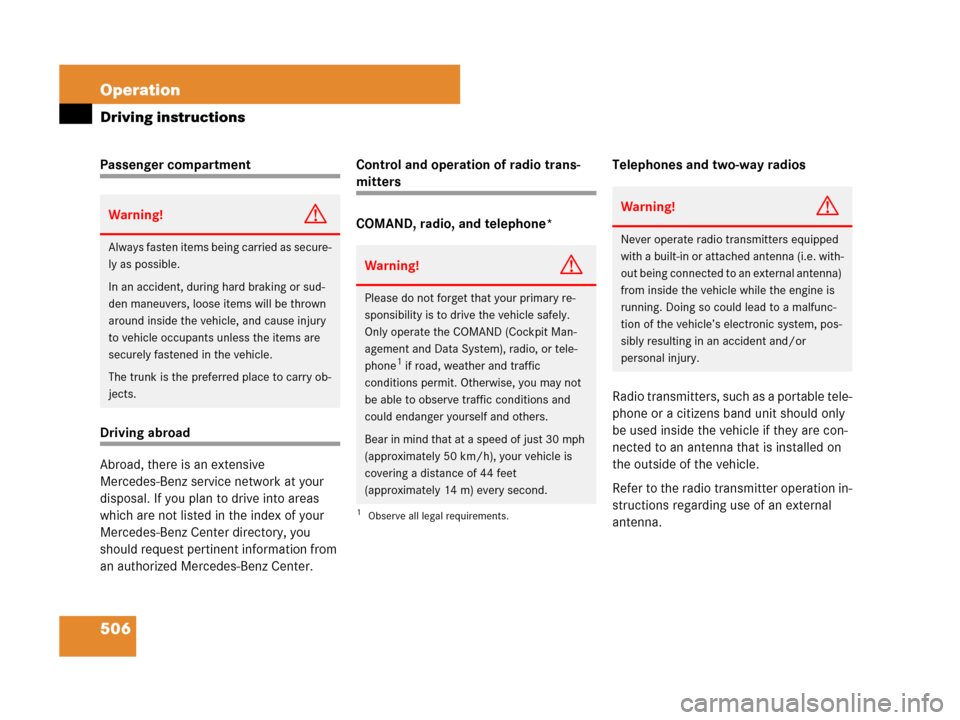
506 Operation
Driving instructions
Passenger compartment
Driving abroad
Abroad, there is an extensive
Mercedes-Benz service network at your
disposal. If you plan to drive into areas
which are not listed in the index of your
Mercedes-Benz Center directory, you
should request pertinent information from
an authorized Mercedes-Benz Center.Control and operation of radio trans-
mitters
COMAND, radio, and telephone*Telephones and two-way radios
Radio transmitters, such as a portable tele-
phone or a citizens band unit should only
be used inside the vehicle if they are con-
nected to an antenna that is installed on
the outside of the vehicle.
Refer to the radio transmitter operation in-
structions regarding use of an external
antenna.
Warning!G
Always fasten items being carried as secure-
ly as possible.
In an accident, during hard braking or sud-
den maneuvers, loose items will be thrown
around inside the vehicle, and cause injury
to vehicle occupants unless the items are
securely fastened in the vehicle.
The trunk is the preferred place to carry ob-
jects.
Warning!G
Please do not forget that your primary re-
sponsibility is to drive the vehicle safely.
Only operate the COMAND (Cockpit Man-
agement and Data System), radio, or tele-
phone
1 if road, weather and traffic
conditions permit. Otherwise, you may not
be able to observe traffic conditions and
could endanger yourself and others.
Bear in mind that at a speed of just 30 mph
(approximately 50 km/h), your vehicle is
covering a distance of 44 feet
(approximately 14 m) every second.
1Observe all legal requirements.
Warning!G
Never operate radio transmitters equipped
with a built-in or attached antenna (i.e. with-
out being connected to an external antenna)
from inside the vehicle while the engine is
running. Doing so could lead to a malfunc-
tion of the vehicle’s electronic system, pos-
sibly resulting in an accident and/or
personal injury.
Page 634 of 723
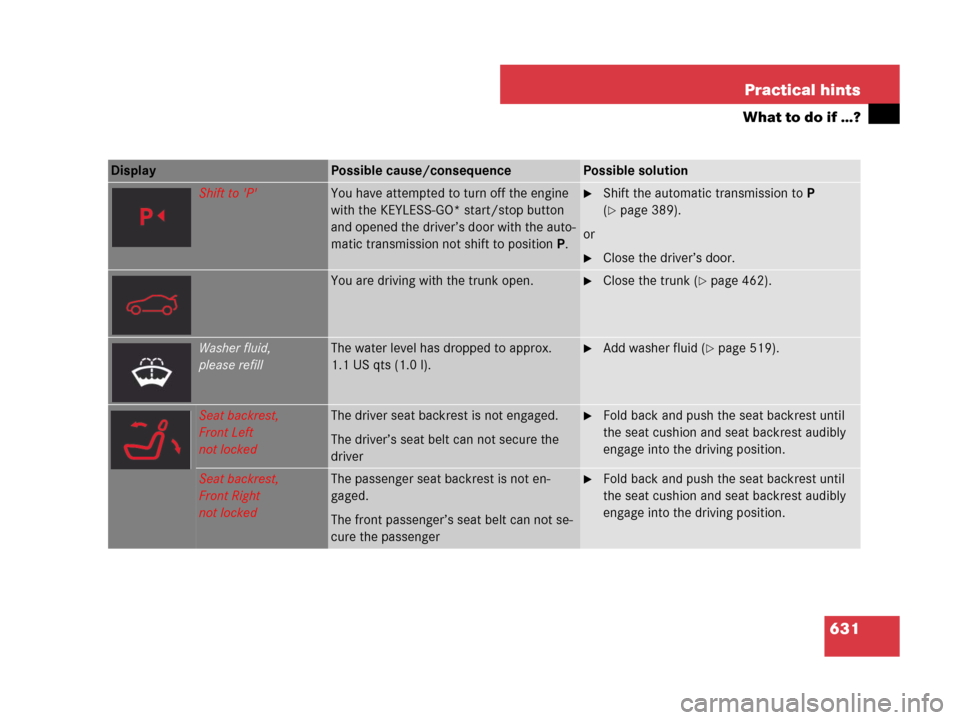
631 Practical hints
What to do if …?
Display Possible cause/consequencePossible solution
Shift to 'P'You have attempted to turn off the engine
with the KEYLESS-GO* start/stop button
and opened the driver’s door with the auto-
matic transmission not shift to positionP.�Shift the automatic transmission toP
(
�page 389).
or
�Close the driver’s door.
You are driving with the trunk open.�Close the trunk (�page 462).
Washer fluid,
please refillThe water level has dropped to approx.
1.1 US qts (1.0 l).�Add washer fluid (�page 519).
Seat backrest,
Front Left
not lockedThe driver seat backrest is not engaged.
The driver’s seat belt can not secure the
driver�Fold back and push the seat backrest until
the seat cushion and seat backrest audibly
engage into the driving position.
Seat backrest,
Front Right
not lockedThe passenger seat backrest is not en-
gaged.
The front passenger’s seat belt can not se-
cure the passenger�Fold back and push the seat backrest until
the seat cushion and seat backrest audibly
engage into the driving position.
Page 635 of 723
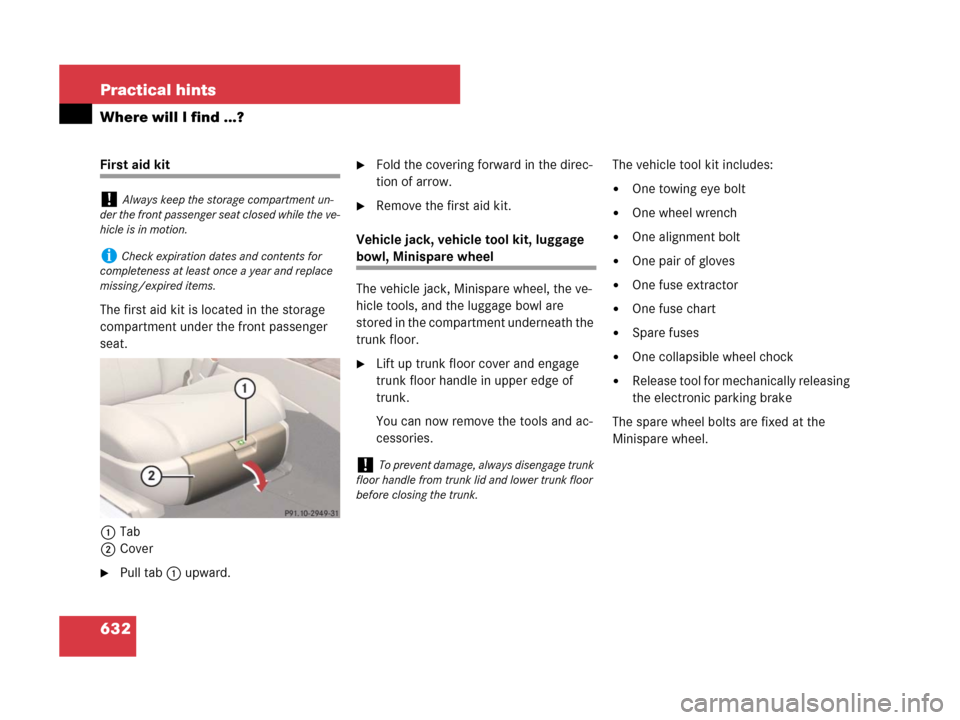
632 Practical hints
Where will I find ...?
First aid kit
The first aid kit is located in the storage
compartment under the front passenger
seat.
1Tab
2Cover
�Pull tab1 upward.
�Fold the covering forward in the direc-
tion of arrow.
�Remove the first aid kit.
Vehicle jack, vehicle tool kit, luggage
bowl, Minispare wheel
The vehicle jack, Minispare wheel, the ve-
hicle tools, and the luggage bowl are
stored in the compartment underneath the
trunk floor.
�Lift up trunk floor cover and engage
trunk floor handle in upper edge of
trunk.
You can now remove the tools and ac-
cessories.The vehicle tool kit includes:
�One towing eye bolt
�One wheel wrench
�One alignment bolt
�One pair of gloves
�One fuse extractor
�One fuse chart
�Spare fuses
�One collapsible wheel chock
�Release tool for mechanically releasing
the electronic parking brake
The spare wheel bolts are fixed at the
Minispare wheel.
!Always keep the storage compartment un-
der the front passenger seat closed while the ve-
hicle is in motion.
iCheck expiration dates and contents for
completeness at least once a year and replace
missing/expired items.
!To prevent damage, always disengage trunk
floor handle from trunk lid and lower trunk floor
before closing the trunk.
Page 637 of 723
634 Practical hints
Where will I find ...?
Minispare wheel
The Minispare wheel is stored in the com-
partment underneath the trunk floor.
1Minispare wheel with spare wheel bolts
in container on wheel rim
2Luggage bowl
3Vehicle tool kit, jack and collapsible
wheel chock
Removing the Minispare wheel
�Turn luggage bowl2 counterclock-
wise.
�Remove luggage bowl2 and vehicle
tool kit3.
�Remove Minispare wheel1.
Setting up the collapsible wheel chock
The collapsible wheel chock serves to
additionally secure the vehicle, e.g. while
changing the wheel.
1Tilt the plates upward
2Fold the lower plate outward
3Insert the plate�Tilt both plates upward1.
�Fold the lower plate outward2.
�Guide the tabs of the lower plate all the
way into the openings of the base
plate3.
For information on where to place wheel
chocks when changing a wheel, see “Lift-
ing the vehicle” (
�page 650).
Page 638 of 723
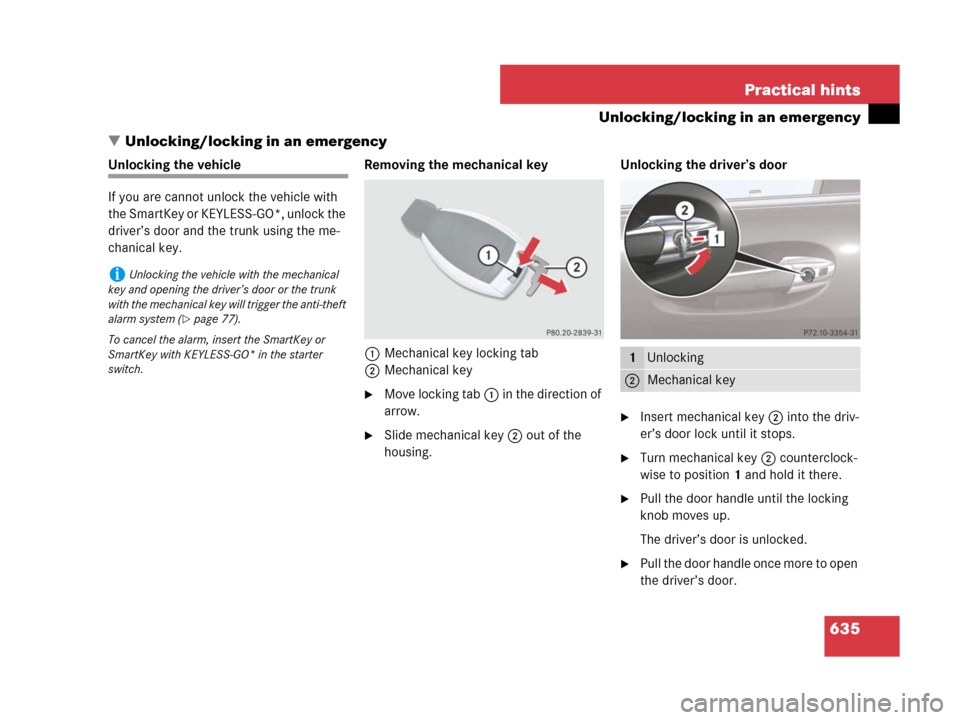
635 Practical hints
Unlocking/locking in an emergency
�Unlocking/locking in an emergency
Unlocking the vehicle
If you are cannot unlock the vehicle with
the SmartKey or KEYLESS-GO*, unlock the
driver’s door and the trunk using the me-
chanical key. Removing the mechanical key
1Mechanical key locking tab
2Mechanical key
�Move locking tab1 in the direction of
arrow.
�Slide mechanical key2 out of the
housing.Unlocking the driver’s door
�Insert mechanical key2 into the driv-
er’s door lock until it stops.
�Turn mechanical key2 counterclock-
wise to position1 and hold it there.
�Pull the door handle until the locking
knob moves up.
The driver’s door is unlocked.
�Pull the door handle once more to open
the driver’s door.
iUnlocking the vehicle with the mechanical
key and opening the driver’s door or the trunk
with the mechanical key will trigger the anti-theft
alarm system (
�page 77).
To cancel the alarm, insert the SmartKey or
SmartKey with KEYLESS-GO* in the starter
switch.
1Unlocking
2Mechanical key
Page 639 of 723
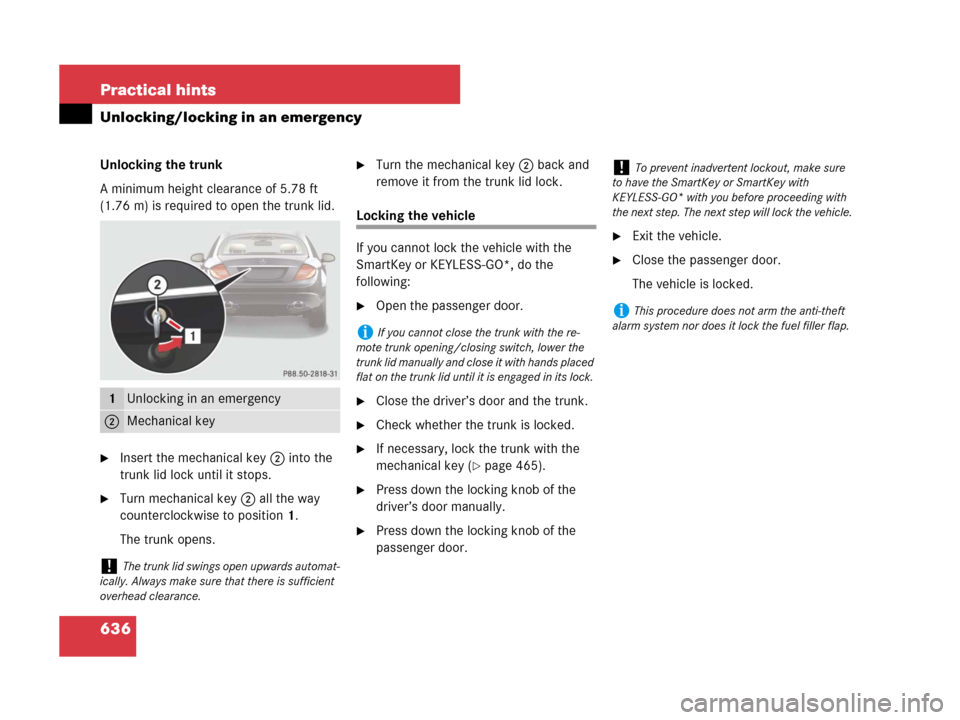
636 Practical hints
Unlocking/locking in an emergency
Unlocking the trunk
A minimum height clearance of 5.78 ft
(1.76 m) is required to open the trunk lid.
�Insert the mechanical key2 into the
trunk lid lock until it stops.
�Turn mechanical key2 all the way
counterclockwise to position 1.
The trunk opens.
�Turn the mechanical key2 back and
remove it from the trunk lid lock.
Locking the vehicle
If you cannot lock the vehicle with the
SmartKey or KEYLESS-GO*, do the
following:
�Open the passenger door.
�Close the driver’s door and the trunk.
�Check whether the trunk is locked.
�If necessary, lock the trunk with the
mechanical key (
�page 465).
�Press down the locking knob of the
driver’s door manually.
�Press down the locking knob of the
passenger door.
�Exit the vehicle.
�Close the passenger door.
The vehicle is locked.
1Unlocking in an emergency
2Mechanical key
!The trunk lid swings open upwards automat-
ically. Always make sure that there is sufficient
overhead clearance.
iIf you cannot close the trunk with the re-
mote trunk opening/closing switch, lower the
trunk lid manually and close it with hands placed
flat on the trunk lid until it is engaged in its lock.
!To prevent inadvertent lockout, make sure
to have the SmartKey or SmartKey with
KEYLESS-GO* with you before proceeding with
the next step. The next step will lock the vehicle.
iThis procedure does not arm the anti-theft
alarm system nor does it lock the fuel filler flap.
Page 653 of 723
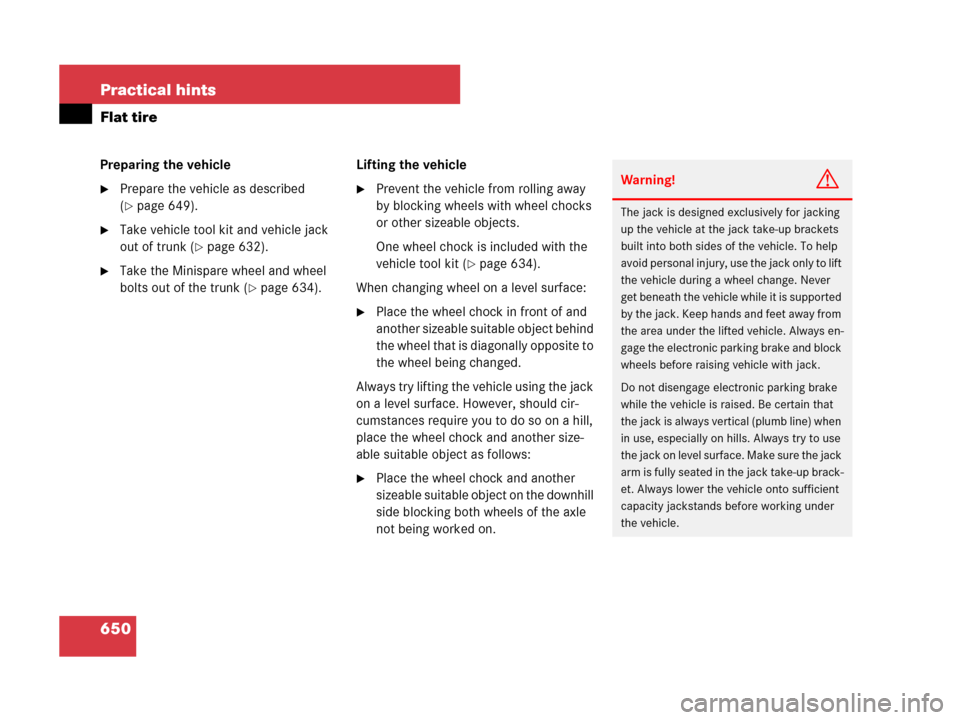
650 Practical hints
Flat tire
Preparing the vehicle
�Prepare the vehicle as described
(
�page 649).
�Take vehicle tool kit and vehicle jack
out of trunk (
�page 632).
�Take the Minispare wheel and wheel
bolts out of the trunk (
�page 634).Lifting the vehicle
�Prevent the vehicle from rolling away
by blocking wheels with wheel chocks
or other sizeable objects.
One wheel chock is included with the
vehicle tool kit (
�page 634).
When changing wheel on a level surface:
�Place the wheel chock in front of and
another sizeable suitable object behind
the wheel that is diagonally opposite to
the wheel being changed.
Always try lifting the vehicle using the jack
on a level surface. However, should cir-
cumstances require you to do so on a hill,
place the wheel chock and another size-
able suitable object as follows:
�Place the wheel chock and another
sizeable suitable object on the downhill
side blocking both wheels of the axle
not being worked on.
Warning!G
The jack is designed exclusively for jacking
up the vehicle at the jack take-up brackets
built into both sides of the vehicle. To help
avoid personal injury, use the jack only to lift
the vehicle during a wheel change. Never
get beneath the vehicle while it is supported
by the jack. Keep hands and feet away from
the area under the lifted vehicle. Always en-
gage the electronic parking brake and block
wheels before raising vehicle with jack.
Do not disengage electronic parking brake
while the vehicle is raised. Be certain that
the jack is always vertical (plumb line) when
in use, especially on hills. Always try to use
the jack on level surface. Make sure the jack
arm is fully seated in the jack take-up brack-
et. Always lower the vehicle onto sufficient
capacity jackstands before working under
the vehicle.
Page 655 of 723
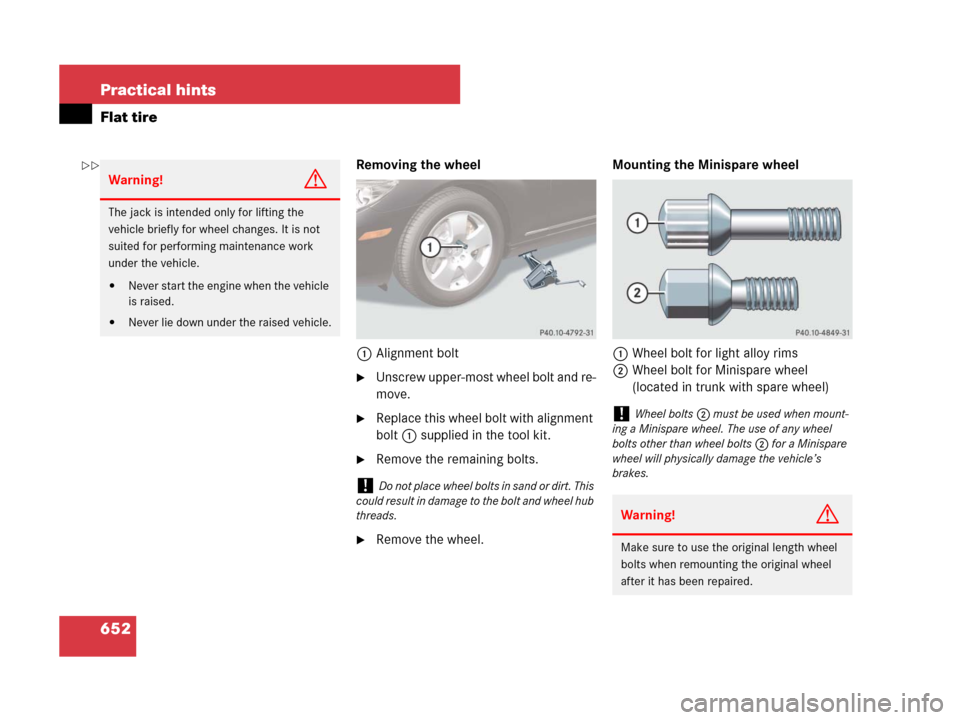
652 Practical hints
Flat tire
Removing the wheel
1Alignment bolt
�Unscrew upper-most wheel bolt and re-
move.
�Replace this wheel bolt with alignment
bolt1 supplied in the tool kit.
�Remove the remaining bolts.
�Remove the wheel.Mounting the Minispare wheel
1Wheel bolt for light alloy rims
2Wheel bolt for Minispare wheel
(located in trunk with spare wheel)
Warning!G
The jack is intended only for lifting the
vehicle briefly for wheel changes. It is not
suited for performing maintenance work
under the vehicle.
�Never start the engine when the vehicle
is raised.
�Never lie down under the raised vehicle.
!Do not place wheel bolts in sand or dirt. This
could result in damage to the bolt and wheel hub
threads.
!Wheel bolts2 must be used when mount-
ing a Minispare wheel. The use of any wheel
bolts other than wheel bolts2 for a Minispare
wheel will physically damage the vehicle’s
brakes.
Warning!G
Make sure to use the original length wheel
bolts when remounting the original wheel
after it has been repaired.
��